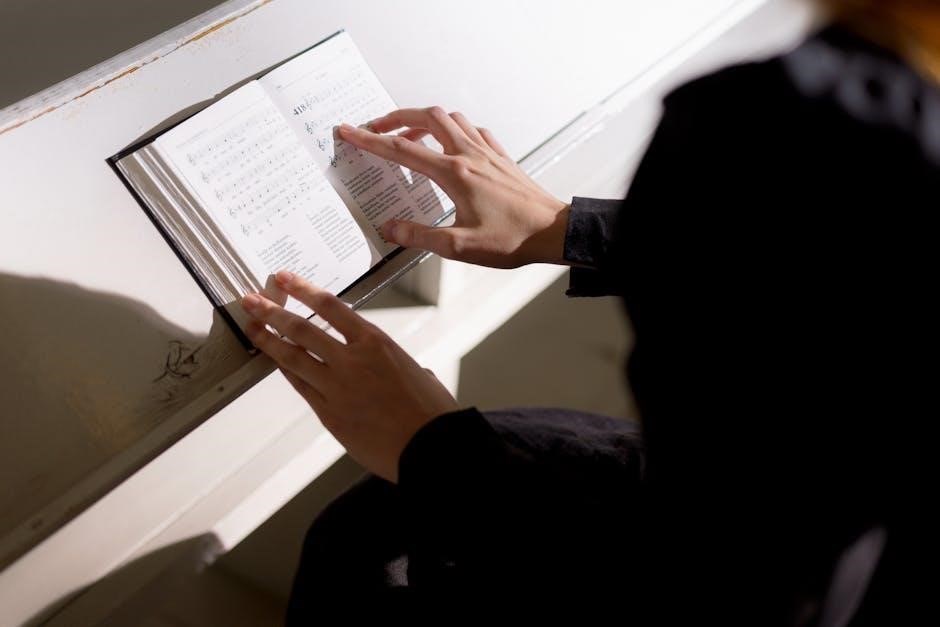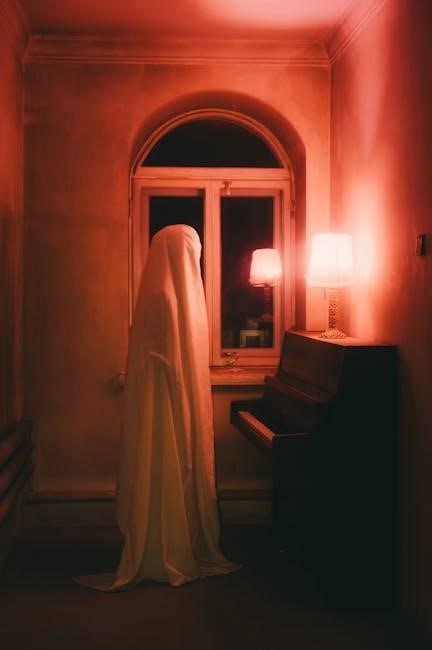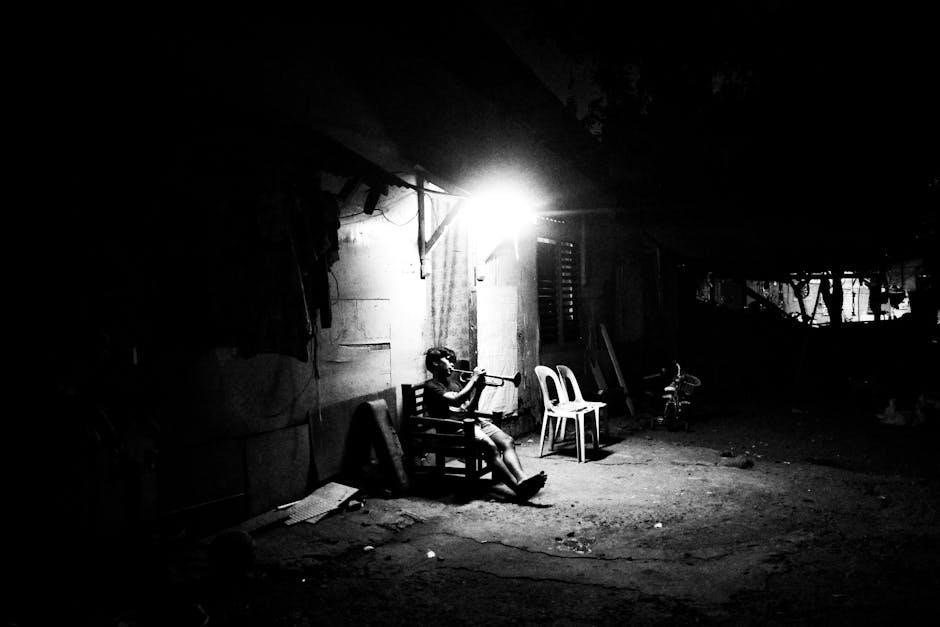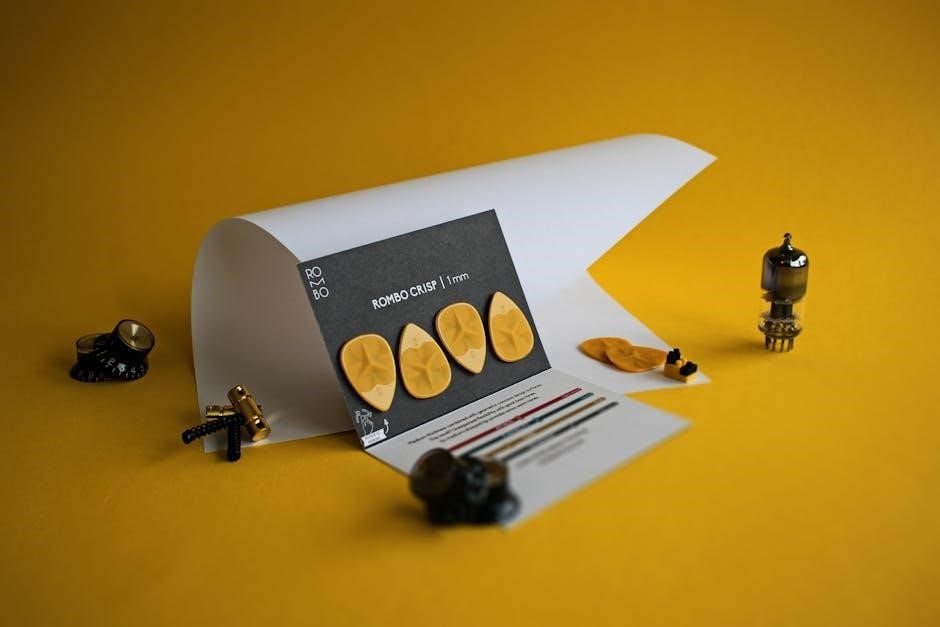Beethoven’s Moonlight Sonata sheet music PDF is a widely sought-after piece, offering pianists a chance to play this beloved composition. Its availability as a free PDF makes it easily accessible online.
Brief Overview

Beethoven’s Moonlight Sonata, or Piano Sonata No. 14 in C-sharp minor, Op. 27, No. 2, is one of the most recognizable and beloved piano pieces in classical music. Composed between 1801 and 1802, it consists of three movements, with the first, Adagio sostenuto, being the most famous. The sonata is celebrated for its dreamy, introspective quality, which inspired the nickname “Moonlight” years after its composition. The sheet music is widely available online as free PDF downloads, making it accessible to pianists of all levels. While the original manuscript is in the public domain, many modern editions offer interpretations and annotations to enhance performance. The piece remains a staple in piano repertoire, cherished for its emotional depth and technical challenges. Its enduring popularity has led to numerous arrangements and interpretations across various media platforms.
Historical Significance
Beethoven’s Moonlight Sonata holds profound historical significance as a cornerstone of classical music. Composed during Beethoven’s early Romantic period, it marked a departure from classical sonata form, embracing a more expressive and innovative style. The piece was dedicated to Countess Julie “Giulietta” Guicciardi, a pupil and close friend, adding a personal touch to its legacy. Its publication in 1802 under the title Sonata Quasi una Fantasia reflected Beethoven’s evolving artistic vision. The sonata’s emotional intensity and technical complexity have influenced generations of composers and pianists. Today, its sheet music remains a vital resource for musicians, preserving Beethoven’s genius for future generations. The availability of free PDFs ensures that this masterpiece continues to inspire and educate, maintaining its place as a pivotal work in musical history.

Popular Appeal
The Moonlight Sonata remains one of the most recognizable and beloved pieces in classical music, captivating audiences worldwide. Its hauntingly beautiful melodies and emotional depth have made it a favorite among pianists and music lovers alike. The sonata’s popularity is further amplified by its frequent use in films, commercials, and other media, introducing it to new generations. The availability of free PDF sheet music has democratized access, allowing both professionals and hobbyists to explore its nuances. Its timeless appeal lies in its ability to evoke powerful emotions, making it a staple in piano repertoire. Whether performed on stage or played privately, the Moonlight Sonata continues to inspire and delight, solidifying its place as a cultural icon. Its enduring popularity ensures that it remains a cherished piece in the world of music.
Historical Background
Composed between 1801 and 1802, Beethoven’s Moonlight Sonata (Op. 27, No. 2) was dedicated to Countess Julie Guicciardi. The nickname “Moonlight” emerged later, inspired by its dreamy, evocative quality.
Composition Date
Beethoven’s Moonlight Sonata (Piano Sonata No. 14 in C-sharp minor, Op. 27, No. 2) was composed between 1801 and 1802. The exact dates of its creation remain unclear, but it is believed to have been written during a period of significant personal and artistic transformation for Beethoven. This timeframe marks the transition from his early to middle compositional periods, often referred to as his “Heroic” phase. The sonata’s emotional depth and innovative structure reflect the composer’s growing mastery and experimentation with musical form. Despite its nickname, the piece was not titled “Moonlight” by Beethoven himself, but rather by the German music critic and pianist Ludwig Rellstab, who likened its dreamy, flowing quality to moonlight on water. This composition remains one of Beethoven’s most celebrated works, showcasing his unparalleled ability to evoke emotion through music.
Dedication
Beethoven’s Moonlight Sonata was dedicated to Countess Julie “Giulietta” Guicciardi, a young aristocrat and one of his piano students. This dedication reflects the deep emotional connection Beethoven felt toward her, though his feelings were unrequited. The countess, known for her beauty and musical talent, inspired Beethoven during a tumultuous period in his life. The sonata’s dedication not only highlights her influence but also underscores the personal and emotional nature of the composition. Despite the romantic undertones, the relationship between Beethoven and Guicciardi remained platonic, adding a layer of poignancy to the piece. This dedication is a testament to Beethoven’s ability to channel intense emotions into his music, creating a work that continues to resonate with listeners worldwide. The Moonlight Sonata remains a timeless tribute to the countess who inspired its creation.

Origin of the Nickname
The Moonlight Sonata earned its nickname from the German music critic and pianist Ludwig Rellstab in 1832. He described the sonata’s first movement as being “like moonlight shining upon the lake of Lucerne.” This poetic imagery captured the piece’s dreamy, evocative quality, leading to its widespread adoption as the Moonlight Sonata. Interestingly, Beethoven himself never referred to it by this name; he simply called it Sonata No. 14 in C-sharp minor, Op. 27, No. 2. The nickname has since become synonymous with the piece, enhancing its mystique and appeal. Despite its popularity, the moniker was added years after the sonata’s composition, reflecting how later interpretations have shaped its identity. The Moonlight label continues to evoke the serene yet profound emotions embedded in Beethoven’s masterpiece, making it one of the most recognizable pieces in classical music.

Structure and Composition
Beethoven’s Moonlight Sonata, composed between 1801 and 1802, consists of three movements: Adagio sostenuto, Allegretto, and Presto agitato, showcasing its emotional depth and technical complexity.
First Movement
The first movement of Beethoven’s Moonlight Sonata, titled Adagio sostenuto, is renowned for its dreamy, introspective quality. Composed in C-sharp minor, it features a hauntingly beautiful melody accompanied by arpeggiated triplet figuration in the right hand and a sustained bass line in the left. This movement is characterized by its lyrical simplicity and emotional depth, with dynamics that gradually build and recede, creating a sense of tension and release. The Adagio sostenuto is technically challenging due to its requirement for precise pedaling and nuanced phrasing. Pianists often focus on maintaining a steady rhythm in the arpeggiated patterns while conveying the piece’s expressive qualities. The movement’s popularity has led to its widespread availability in free PDF sheet music, making it accessible for study and performance by pianists of all levels.

Second Movement
The second movement of Beethoven’s Moonlight Sonata, marked Allegretto, offers a stark contrast to the first movement’s introspective nature. Composed in D-flat major, it features a lively, almost dance-like rhythm with a triplet motif that creates a sense of forward momentum. This movement is structured in a scherzo-like form, with a central trio section that provides a moment of lyricism before returning to the energetic outer sections. The Allegretto is technically demanding, requiring precise articulation and dynamic control to maintain its playful yet refined character. Pianists often find the movement’s rhythmic clarity and balance between the hands to be particularly challenging. Despite these demands, the second movement remains a delightful and rewarding piece to perform, with its sheet music widely available in PDF format for study and interpretation.

Third Movement
The third movement of Beethoven’s Moonlight Sonata is a dramatic and technically demanding piece, marked Presto agitato. It is written in C-sharp minor and features a sonata-rondo form, blending elements of both sonata and rondo structures. The movement is characterized by its intense energy, rapid arpeggios, and dramatic dynamic contrasts. Pianists must master intricate fingerwork and maintain clarity amidst the furious tempo. The sheet music for this movement is widely available in PDF format, allowing performers to study and practice its challenging passages. The third movement stands as a testament to Beethoven’s innovative composition style, offering a thrilling conclusion to the sonata. Its emotional depth and technical demands make it a favorite among advanced pianists seeking to showcase their skill and artistry.
Key and Tempo
Beethoven’s Moonlight Sonata is composed in the key of C-sharp minor, Op. 27, No. 2. The first movement, Adagio sostenuto, features a slow and contemplative tempo, while the second movement, Allegretto, is marked by a lighter, more graceful pace. The third movement, Presto agitato, is fast and dramatic, showcasing technical brilliance. The key of C-sharp minor contributes to the sonata’s dark, introspective nature, while the contrasting tempos create a dynamic emotional journey. The sheet music PDFs available online highlight these markings, ensuring performers can accurately interpret Beethoven’s intentions. The interplay of key and tempo is central to the sonata’s enduring appeal, making it a cornerstone of piano repertoire. These elements are meticulously detailed in the PDF scores, guiding pianists through the piece’s intricate emotional and technical landscape.
Sheet Music Details
Beethoven’s Moonlight Sonata sheet music PDF is widely available online, offering free downloads of the full score, including all three movements, in both PDF and MIDI formats for pianists of all levels.
Availability of Free PDFs
Beethoven’s Moonlight Sonata sheet music PDF is readily available for free download from various online platforms. Websites such as SheetMusic-Free.com and other repositories offer the full score, including all three movements, in PDF and MIDI formats. These files are accessible to pianists of all skill levels, making it easy for enthusiasts to practice and perform this iconic piece. While some platforms may require registration, many provide direct downloads without additional requirements. The availability of free PDFs has democratized access to this masterpiece, ensuring that anyone with an internet connection can explore and play Beethoven’s beloved composition. However, the quality and accuracy of free sheet music can vary, so it’s important to verify the source for the best experience.
Quality of Free Sheet Music

The quality of free Moonlight Sonata sheet music PDFs varies significantly across different platforms. While some websites offer high-quality, accurate scores, others may provide versions with errors or poor formatting. Free sheet music often lacks the meticulous editing and attention to detail found in paid editions, which can lead to discrepancies in dynamics, articulations, and other musical nuances. Additionally, some free PDFs may be scanned copies of older editions, resulting in blurry or hard-to-read text. Pianists seeking the most accurate representation of Beethoven’s work may find it worthwhile to invest in a reputable edition. However, for casual practice or initial exploration, free sheet music can still provide a functional and accessible starting point, allowing musicians to familiarize themselves with the piece before upgrading to a premium version.
Legal Considerations
Downloading and using Moonlight Sonata sheet music PDFs requires attention to copyright laws. Since Beethoven’s works are in the public domain, the music itself is free to use and distribute. However, specific arrangements or editions of the sheet music may still be under copyright, depending on the publisher and the extent of their editorial contributions. Users should verify the source and licensing terms of any free PDF to ensure compliance with legal requirements. Websites offering free downloads often rely on public domain scores or Creative Commons licenses, but it’s essential to check for any restrictions on commercial use or redistribution. Additionally, supporting reputable publishers by purchasing sheet music can help sustain the creation of high-quality musical resources. Always prioritize legal sources to avoid potential copyright infringement issues.
Recommended Editions
For those seeking high-quality Moonlight Sonata sheet music PDFs, several editions are highly recommended. The Henle Verlag edition is praised for its meticulous editorial standards and historical accuracy, making it a favorite among scholars and performers. The Bärenreiter edition is another excellent choice, offering clear notation and insightful commentary. For students, the Schirmer edition provides practical fingerings and a manageable layout. Additionally, Urtext editions are ideal for those seeking the composer’s original intent without additional interpretations. When purchasing or downloading, ensure the edition aligns with your skill level and performance goals. These editions are widely available on platforms like Musicnotes and Sheet Music Plus, ensuring access to reliable and well-curated scores. Investing in a reputable edition enhances both practice and performance quality.
Online Platforms
Several online platforms offer convenient access to Moonlight Sonata sheet music PDFs. Musicnotes and Sheet Music Plus provide high-quality, legally licensed versions, often with interactive features. MuseScore is a popular choice for free and paid scores, offering a wide range of arrangements. Additionally, the International Music Score Library Project (IMSLP) hosts public domain editions, making it a valuable resource for those seeking free access. These platforms cater to both professionals and amateurs, ensuring that pianists of all levels can find suitable versions. Many sites also offer digital downloads, allowing immediate access to the music. With these platforms, finding and downloading the Moonlight Sonata sheet music PDF has never been more convenient. They provide a seamless way to explore and perform this timeless piece.

Performance Tips
Mastering the Moonlight Sonata requires a delicate touch and steady tempo. Focus on dynamic control to convey its emotional depth, ensuring a dreamy yet expressive performance. Practice slowly to refine intricate passages.
Technical Challenges
The Moonlight Sonata presents several technical challenges, particularly in its first movement. The arpeggio patterns require a smooth, flowing technique, while the left-hand accompaniment demands a soft, consistent touch. Maintaining dynamics and pedaling appropriately is crucial to preserve the piece’s dreamy quality. The second movement, with its 3/4 time signature, challenges pianists to maintain a steady rhythm and legato playing. The third movement, marked by rapid arpeggios and double thirds, demands exceptional finger strength and dexterity. Pianists must also navigate sudden dynamic shifts and intricate fingerings. To overcome these challenges, consistent practice and attention to detail are essential. Focusing on slow practice to build accuracy and control can help master the sonata’s technical demands. Overcoming these challenges allows pianists to fully express the piece’s emotional depth and complexity.
Practice Strategies
Mastering the Moonlight Sonata requires a structured approach to practice. Begin by breaking the piece into smaller sections, focusing on challenging passages like the arpeggio patterns in the first movement. Slow practice is essential to build accuracy and control, especially in the third movement’s rapid arpeggios. Use a metronome to gradually increase tempo while maintaining clarity. Isolate difficult measures and repeat them until they feel natural. Pay attention to dynamics and pedaling, as these elements are critical to the sonata’s expressive quality. Practice hands separately to refine articulation and finger independence. Incorporate varied practice speeds to ensure technical mastery and musicality. Recording sessions can help identify areas for improvement. Consistent, focused practice will help pianists overcome the sonata’s technical and interpretive challenges, leading to a polished and emotionally resonant performance.
Interpretive Approaches
Interpreting the Moonlight Sonata requires a deep connection to its emotional core. Pianists often emphasize the dreamy, introspective quality of the first movement, using delicate pedaling and nuanced dynamics to convey its haunting beauty. The second movement, with its gentle, lyrical melody, calls for a sense of calm and restraint, while the third movement demands fiery passion and technical precision. Many performers choose to slightly slow the tempo in the first movement to enhance its expressive qualities, while others opt for a more dramatic contrast between movements. The use of rubato is also a common interpretive choice, allowing for subtle expressive timing. Balancing technical mastery with emotional depth is key to delivering a compelling performance of this iconic piece.

Cultural Impact
The Moonlight Sonata has transcended classical music, appearing in films, TV shows, and commercials, making it a cultural icon. Its haunting beauty influences composers and remains a popular choice for various arrangements.
Use in Media
Beethoven’s Moonlight Sonata has been widely featured in various forms of media, including films, television shows, and commercials. Its haunting and evocative qualities make it a popular choice for setting emotional tones in storytelling. The piece has been used in movies to convey drama, romance, and suspense, while in TV shows, it often accompanies moments of introspection or heightened emotion. Additionally, the sonata has been incorporated into commercials to create a sophisticated or nostalgic atmosphere. Its universal appeal ensures its continued presence in media, making it a cultural icon that resonates with diverse audiences. The Moonlight Sonata remains a timeless piece, bridging classical music with modern storytelling through its enduring emotional impact.
Popular Arrangements
Beethoven’s Moonlight Sonata has inspired countless arrangements across various genres and instruments. Beyond its original piano form, it has been transcribed for guitar, strings, and even full orchestras, maintaining its emotional depth. Many modern artists have reimagined the piece, blending it with electronic beats or jazz improvisations, making it accessible to new audiences. The sonata’s first movement, in particular, is a favorite for weddings and recitals due to its serene and romantic qualities. Additionally, its adaptability has led to arrangements for solo instruments like the violin and cello, further showcasing its universal appeal. These interpretations highlight the sonata’s timeless beauty and its ability to transcend classical music boundaries, resonating with listeners of all musical preferences. The Moonlight Sonata remains a versatile and enduring piece, continuing to inspire creative reinterpretations.
Influence on Other Composers
Beethoven’s Moonlight Sonata has profoundly influenced numerous composers, shaping the trajectory of classical and romantic music. Its innovative use of tonality and emotional depth inspired composers like Chopin and Liszt, who admired its expressive qualities. The sonata’s dreamy, introspective nature became a hallmark of the Romantic era, encouraging composers to explore similar emotional landscapes. Many later works reflect its influence, particularly in the use of dramatic contrasts and lyrical melodies. The sonata’s structure and harmonic experimentation also paved the way for future composers to push boundaries in their own compositions. Its enduring popularity ensures that the Moonlight Sonata remains a cornerstone of musical inspiration, continuing to captivate and influence artists to this day. The availability of its sheet music in PDF format has further facilitated its study and interpretation by musicians worldwide.
The Moonlight Sonata sheet music PDF remains a timeless treasure, offering pianists a gateway to Beethoven’s genius. Its enduring appeal ensures it continues to inspire and delight music enthusiasts worldwide.
The Moonlight Sonata sheet music PDF is a highly sought-after resource for pianists, offering access to Beethoven’s iconic composition. Composed between 1801 and 1802, this piece, officially titled Piano Sonata No. 14 in C-sharp minor, Op. 27, No. 2, is renowned for its emotional depth and technical challenges. The sheet music is widely available online, with free PDF downloads providing pianists of all levels the opportunity to explore its beauty. While free versions are accessible, their quality can vary, and musicians often seek high-quality editions for optimal performance. Legal considerations, such as copyright, are minimal due to the piece’s public domain status. Recommended editions include those from reputable publishers, ensuring accuracy and clarity; Online platforms like SheetMusic and others offer convenient access to both free and premium versions, making the Moonlight Sonata a timeless and accessible masterpiece for pianists worldwide.
Final Thoughts
The Moonlight Sonata sheet music PDF remains a cornerstone of classical piano repertoire, offering a profound musical experience. Its emotional depth and technical challenges make it a favorite among pianists of all levels. The widespread availability of free PDF downloads has democratized access to this masterpiece, allowing anyone to explore its beauty. However, opting for high-quality editions ensures a more authentic and rewarding experience. Legal considerations are minimal due to its public domain status, making it freely accessible. For those seeking precision and clarity, investing in reputable publications is advisable. Whether downloaded for free or purchased, the Moonlight Sonata continues to inspire and captivate, embodying Beethoven’s genius. Pianists are encouraged to explore both free and premium resources to fully appreciate this timeless work.
